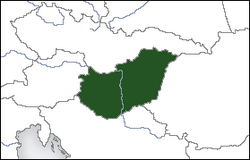| Kingdom of Hungary Magyar Királyság (Hungarian) Timeline: Alexander the Liberator
OTL equivalent: Hungary | ||||||
|---|---|---|---|---|---|---|
|
||||||
| Motto: "Regnum Mariae Patrona Hungariae"(Latin) "Kingdom of Mary, the Patron of Hungary" |
||||||
| Anthem: "Himnusz" (Hungarian) "Hymn" |
||||||
| Capital (and largest city) | Budapest | |||||
| Other cities | Kecskemét, Pécs, Békéscsaba, Miskolc, Szeged | |||||
| Official languages | Hungarian | |||||
| Ethnic groups (2011) | 80.7% Hungarians 14.7% not declared 3.1% Roma 1.3% Germans |
|||||
| Religion | Roman Catholicism | |||||
| Demonym | Hungarian | |||||
| Government | Unitary parliamentary constitutional monarchy | |||||
| - | Monarch | Charles V | ||||
| - | Prime Minister | Viktor Orbán | ||||
| Legislature | Országgyűlés | |||||
| Establishment | ||||||
| - | Principality of Hungary | 895 | ||||
| - | Battle of Pressburg | 4–6 July 907 | ||||
| - | Christian Kingdom | 25 December 1000 | ||||
| - | Golden Bull of 1222 | 24 April 1222 | ||||
| - | Battle of Mohács | 29 August 1526 | ||||
| - | Liberation of Buda | 2 September 1686 | ||||
| - | Revolution of 1848 | 15 March 1848 | ||||
| - | Austro-Hungarian Empire | 20 March 1867 | ||||
| - | Treaty of Trianon | 4 June 1920 | ||||
| Area | ||||||
| - | Total | 93,030 km2 35,920 sq mi |
||||
| - | Water (%) | 0.74 | ||||
| Population | ||||||
| - | 2017 estimate | 9,797,561 | ||||
| - | Density | 105.3/km2 272.7/sq mi |
||||
| Currency | Forint (HUF) |
|||||
| Time zone | CET (UTC+1) | |||||
| - | Summer (DST) | CEST (UTC+2) | ||||
| Date formats | yyyy.mm.dd. | |||||
| Drives on the | right | |||||
| Calling code | +36 | |||||
| Patron saint | Saint Stephen | |||||
Hungary (Hungarian: Magyarország), officially the Kingdom of Hungary (Hungarian: Magyar Királyság), is a country in Central Europe that covers an area of 93,030 square kilometres (35,920 sq mi) in the Carpathian Basin. Hungary is bordered by Czechoslovakia to the north, Russia to the northeast, Austria to the northwest, Romania to the east, and Yugoslavia to the south and southwest. The official language is Hungarian, which is the most widely spoken Uralic language in the world. Hungary's capital and its largest city and metropolis is Budapest, a significant economic hub, classified as a leading global city. Major urban areas include Debrecen, Szeged, Miskolc, Pécs and Győr.
Following centuries of successive habitation by Celts, Romans, West Slavs, Gepids and Avars, the foundation of Hungary was laid in the late 9th century by the Hungarian grand prince Árpád in the conquest of the Carpathian Basin. His great grandson Stephen I ascended the throne in 1000, converting the country to a Christian kingdom. By the 12th century, Hungary became a middle power within the Western world, reaching a golden age by the 15th century. Following the Battle of Mohács in 1526 and about 150 years of partial Ottoman occupation (1541–1699), Hungary came under Habsburg rule, and later formed the great power Austro–Hungarian Empire together with Austria.
Hungary's current borders were established in 1920 by the Treaty of Trianon after World War I, when the country lost 71% of its territory, 58% of its population, and 32% of ethnic Hungarians. Following the interwar period, Hungary joined the Axis Powers in World War II, suffering significant damage and casualties.
In the 21st century, Hungary is a middle power and has the world's 57th largest economy by nominal GDP, as well as the 58th largest by PPP, out of 191 countries measured by IMF. As a substantial actor in several industrial and technological sectors, it is the world's 35th largest exporter and 34th largest importer of goods. Hungary is an OECD high-income economy with a very high standard of living. It keeps up a social security and universal health care system, and a tuition-free university education. Hungary performs well in international rankings: it is 20th in quality of life, 24th in Good Country Index, 28th in inequality-adjusted human development, 32nd in the Social Progress Index, 33rd in Global Innovation Index and ranks as the 15th safest country in the world.
| ||||||||||||||||||||




